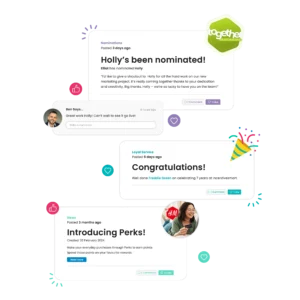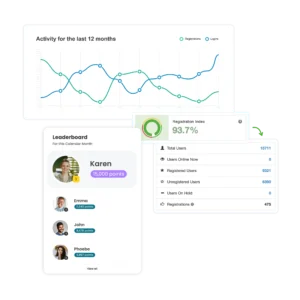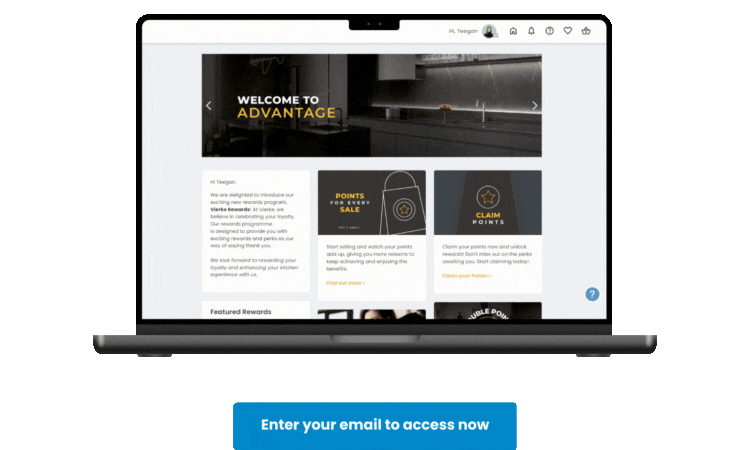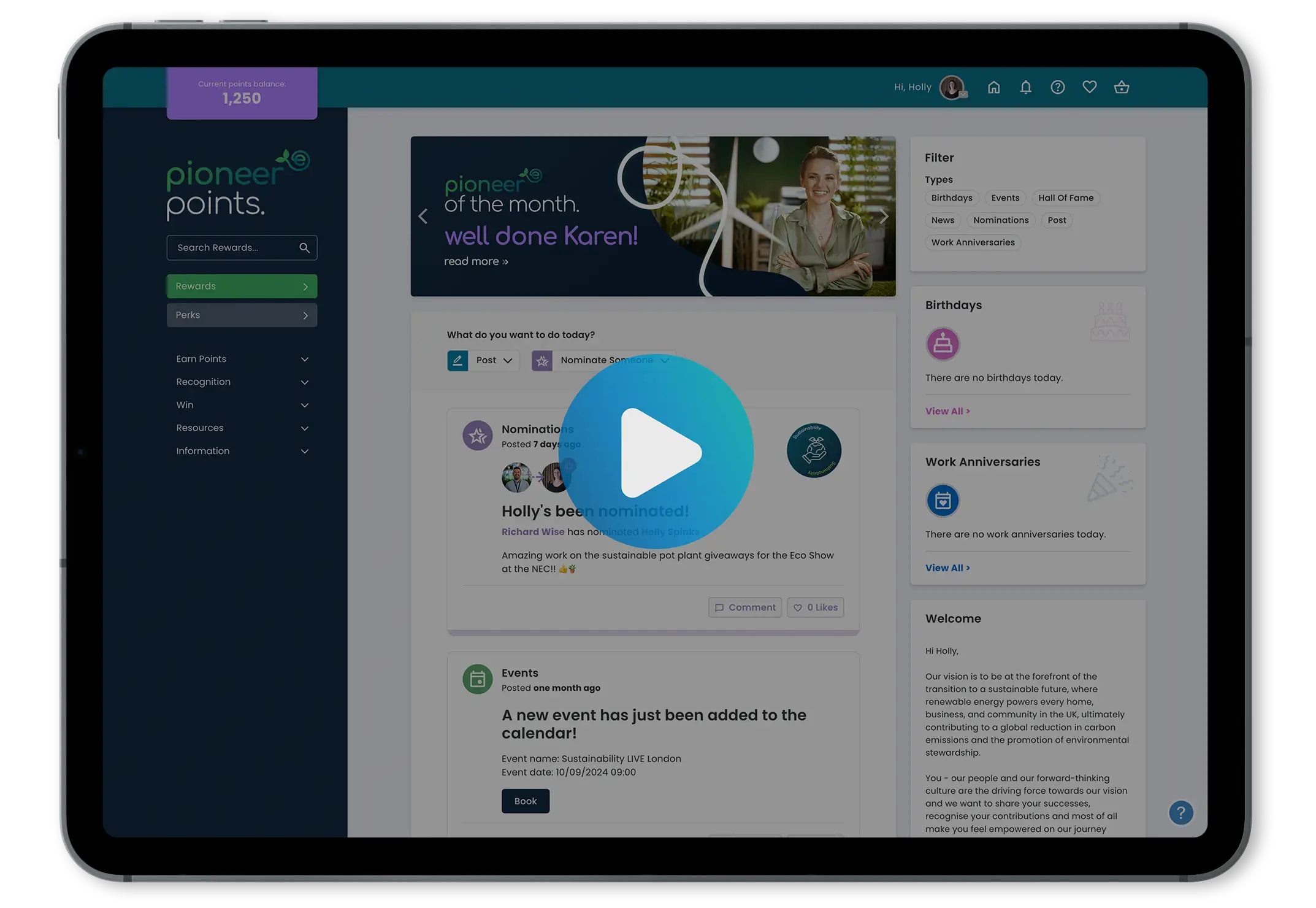


Social recognition transforms workplaces into supportive, inclusive spaces where people feel genuinely valued. This under-used culture-booster is about more than just providing a token gesture of appreciation; it’s about fostering positive connections through colleague recognition.
This is the practice of peers acknowledging one another’s contributions, achievements and the small acts that often go unnoticed. With daily gratitude comes a sense of community, which encourages employees to bring their best selves to work.
So it certainly shouldn’t be underestimated!
Skip to:
What is social recognition?
Social recognition is a form of employee recognition that focuses on the power of everyday gratitude and appreciation between colleagues. It’s a simple, human gesture that makes a massive difference in the workplace.
Imagine those spontaneous, heartfelt acknowledgments we give to those we work alongside – recognising both their achievements and the everyday actions that brighten our workdays – well, that’s it!
Unlike hierarchical recognition (from management down the chain), social recognition flows naturally among colleagues. It focuses on authentic appreciation, rather than structured, formal rewards.
As a result, it creates a culture of positivity, where individuals feel truly seen and valued by those who work directly with them.
The genuine moments when peers show appreciation help shape an environment that boosts retention, improves productivity and ultimately creates a happier workplace. This daily practice of recognition between colleagues makes work feel more like a collaborative community and less like a corporate ladder.

Why is Regular Recognition Between Colleagues so Important?
The benefits of social recognition are undeniable as research shows its positive effects on employee engagement and wellbeing.
In fact, companies with robust social recognition programmes report an increase in employee engagement by up to 55% and productivity and retention soar by nearly 40% as workers feel more satisfied and committed to their teams.
A recent survey also revealed that organisations with effective recognition programmes see a 31% decrease in voluntary turnover, as employees develop a strong sense of loyalty and commitment to the workplace community.
But when we talk about social recognition, we’re looking at the benefits of colleague-led appreciation rather than top-down recognition.
Here’s why that distinction matters…
 Harness psychology
Harness psychology
Being acknowledged by peers carries unique psychological benefits, strengthening morale, trust and the sense of belonging within a team.
This kind of recognition aligns with fundamental psychological needs, especially Maslow’s need for belonging, and helps employees feel integral to the team.
Being thanked by a peer taps into intrinsic motivation, helping people feel genuinely valued and connected to their work community.
This results in a positive ripple effect: where employees are more likely to go above and beyond in their roles, further fuelling a culture of appreciation and respect.
 Build a strong company culture
Build a strong company culture
Social recognition programmes play a crucial role in creating peer-led environments.
By implementing platforms with features like digital ‘thank you’ cards or virtual ‘shout-outs’, companies make it easy for employees to give spontaneous, real-time praise.
These programmes support a culture where recognition is accessible, frequent and authentic…
…qualities that are essential for maintaining high morale and engagement.
Unlike praise from managers (which can sometimes feel transactional), colleague recognition is about authentic appreciation from those impacted directly. Being appreciated by someone who directly benefits from your actions can feel more genuine and meaningful.

Building a Recognition-Rich Culture
For effective social recognition to take place, organisations need easily accessible platforms that take the ‘over the desk hi-five’ and transform it into something more meaningful.
This makes recognition visible throughout the organisation (not just a one-to-one fleeting moment) and encourages participation in every department.
Leaders play a critical role by setting the example; when they publicly acknowledge contributions, they set a standard that inspires others to follow suit.
Creating a culture where employees feel comfortable recognising one another starts at the top but it should grow most organically among peers.
Here are some key practices to build a recognition-rich environment:
- Make recognition easy and accessible:
Providing platforms where employees can easily thank each other is key.
Many organisations implement digital “shout-out” boards or virtual social recognition programmes that let team members highlight their colleagues’ achievements in real-time. - Lead by example:
When leaders openly thank team members, they set a tone that invites everyone to participate in the culture of gratitude. By regularly recognising the everyday efforts of their teams, leaders make social recognition a visible, integral part of workplace culture. - Encourage small, frequent gestures:
Recognition doesn’t have to be reserved for major achievements.
In fact, social recognition works best when people feel comfortable appreciating the little things – like a colleague who shares a helpful resource, supports during a challenging project or lifts spirits with a positive attitude.
- Set up an employee-led steering group:
Let the team ‘on-the-ground’ run the show. Select employees from all the different areas of your business and empower them to make key decisions over any rewards that are to be presented to deserving colleagues.

The Types of Social Recognition
Implementing social recognition doesn’t have to be elaborate – even small gestures can make a big difference.
Here are a few examples that illustrate the impact small token gestures given throughout the working week can have on colleague satisfaction and engagement:
Shout-Out Channels on Internal Communication Platforms
Some companies set up dedicated Slack channels or Teams groups solely for sharing shout-outs. Here, colleagues can post messages acknowledging others’ contributions, making recognition a visible, public act that everyone can appreciate.
Recognition Events
Regular events where colleagues can give “spotlight” awards or share stories about how someone helped them create a shared sense of accomplishment. These events, whether held monthly or quarterly, bring teams together and solidify the importance of social recognition in the company culture.
Informal “Peer Awards”
Peer awards, like certificates, badges or fun tokens, make recognition enjoyable and memorable. One company even created “Employee of the Moment” awards where team members could nominate someone to receive a small token (such as a coveted parking spot) that recognised their helpfulness and teamwork.
Nomination-Based Awards
Some companies incorporate nomination systems, where employees can vote for or nominate colleagues for special awards. These awards often come with titles like “Peer Spotlight,” and add an element of fun and personal connection.
Points-Based Systems
Some organisations use points-based programmes where employees can award each other points for contributions. These points can often be accumulated and redeemed for small rewards, like vouchers or tech goodies. This setup provides additional motivation while keeping the recognition meaningful and accessible.
By embracing social recognition, organisations make appreciation a natural part of the workday, reinforcing its importance and creating a space where everyone’s contributions are celebrated.

Examples Social Recognition in Action
Let’s look at real-life examples of companies successfully implementing social recognition and the specific impacts they’ve seen on their workplace culture.
Example 1: Accenture’s Recognition Platform
Accenture, a global consulting firm, implemented a peer-to-peer recognition programme that uses digital badges and awards points. This programme allows employees to give each other points for outstanding teamwork, helping with project demands or demonstrating leadership qualities. The points earned can be redeemed for rewards, encouraging active participation.
The results were significant: employee engagement scores increased and retention improved by over 30% as employees felt more valued by their peers.
Example 2: Google’s “Thanks” Programme
Google’s “Thanks” programme is a great example of colleague recognition embedded into company culture. Through the programme, employees can send digital “thank you” cards to each other, highlighting specific achievements or simply acknowledging the little things.
The initiative not only boosted morale but also fostered a deeper sense of connection among employees. This focus on peer-to-peer recognition contributed to Google’s reputation for a collaborative, positive workplace, helping attract and retain top talent.
Example 3: Zappos’ “Co-worker Bonus” Programme
Zappos, known for its unique work culture, took a creative approach to social recognition with its “Co-worker Bonus” programme. Every month, employees are given a budget to distribute bonuses to their colleagues. This budget allows employees to show appreciation with small monetary rewards, reinforcing the culture of gratitude.
The programme has been effective in strengthening bonds between team members and enhancing Zappos’ company values.
Example 4: Shopify’s “Moment Makers” Initiative
Shopify introduced its “Moment Makers” programme, a nomination-based approach to peer recognition. Colleagues nominate one another for embodying the company’s values, and winners receive badges and public recognition. By focussing this programme on values, Shopify ensures that social recognition supports the organisation’s goals and culture.
Employees feel appreciated not just for work performance but for how they contribute to the overall spirit and values of the company.

Overcoming Challenges in Implementation
Implementing a social recognition initiative does come with its challenges.
Organisations may face initial resistance from employees who are unfamiliar with recognition driven from within, or they might struggle to find the right platform for their needs.
Here are some practical tips to overcome these challenges:
-
- Start small and scale:
Begin by encouraging social recognition in small groups or departments. Run a pilot, then, as the concept takes hold, expand it company-wide. This gradual approach can make the practice feel less daunting for those new to peer recognition. - Use familiar technology:
If employees already use a communication platform like Slack or Microsoft Teams, make the recognition programme accessible from there and promote it via already established channels. This keeps recognition visible and accessible within existing tools. - Share stories:
Regularly share stories of meaningful recognition to inspire others. By highlighting how employees feel after receiving appreciation, the organisation can reinforce the value of a recognition-rich culture. - Provide resources and training:
Host workshops or informational sessions to explain the importance of social recognition and provide employees with tools to recognise others effectively.
- Start small and scale:

The Lasting Impact of Social Recognition
Social recognition boosts morale, productivity, and retention rates.
Research highlights a 55% increase in engagement and 40% improved retention for companies using social recognition effectively.
Frequent appreciation from peers encourages positive behaviour, creating a culture of trust and unity. Recognising daily contributions, like helping with a task or sharing insights, boosts job satisfaction and creates a strong sense of belonging.
As more companies recognise the value of a people-centred workplace, social recognition is set to become an integral part of corporate culture. It’s a proven strategy that empowers employees to build relationships, foster trust and increase their commitment. Embracing social recognition shows a commitment to cultivating a workplace where everyone feels they belong, can contribute and are valued for their efforts.
So, it’s an investment in people that pays off in spades.



![*FREE GUIDE* How to implement a fantastic company culture in 6 steps Enter your business email for instant access. {{ include_custom_fonts({"Poppins":["Semi Bold"]}) }}](https://no-cache.hubspot.com/cta/default/5921162/interactive-188034983837.png)






